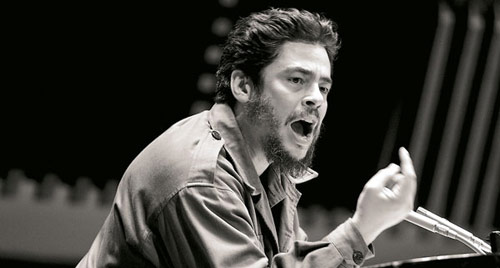
I wake up early this morning. Not just because it’s a 9 a.m. screening, but because it’s a 4+-hour film at the Ryerson, by far my least favorite theater used in the festival. The Ryerson isn’t actually a movie theater for most of the year; it’s a college auditorium. So the seats are narrow, there isn’t much leg room, and the rake (the change in elevation) is flatter than a traditional theater, much less stadium seating. What this means is that the only way I’m going to be even remotely comfortable for Steven Soderbergh’s Che is if I get an aisle seat. So I get in line an extra hour early. At least it’s not raining.
The film is a surprisingly straightforward bio-pic of Ernesto ‘Che’ Guevara. Like Soderbergh did in Traffic, he uses various film stocks and color schemes to separate the various storylines: Che in Mexico before heading to Cuba, Che in the jungles and hills of Cuba, Che speaking at the United Nations several years later. But once you get used to that framework, the story moves through its paces. Only a faux-overture feels the least bit postmodern.
Those unfamiliar with the Cuban Revolution will find much to learn here, though anyone relying on a movie for that kind of information is asking for superficiality. And while the movie isn’t out to make Che into some kind of saint, it doesn’t do anything to puncture the balloon of reverence many people feel for him. Benicio Del Toro is fine in the lead role, though I was surprised at how low-key his performance is. It’s certainly not Oscar-bait, for which I guess I should be grateful. And Soderbergh knows how to edit his footage together, keeping everything moving forward, never letting the audience lose track of the story.
The film loses its narrative thrust, though, in the second half, when it skips ahead several years to Guevara’s attempts to foment a revolution in Bolivia. Che uses an interesting rhyming structure, so that we’re forced to notice the contrasts between the Cuban and Bolivian situations and why what works in one didn’t work in the other. But once a thoughtful viewer catches on to what Soderbergh is doing (and I did within a half hour of intermission), the rest becomes somewhat tedious. Yes, there’s a Malick influence in how Soderbergh shoots in the dry hills of Bolivia, but even that focus on nature isn’t enough. If you didn’t know what happened in Cuba or Bolivia in the ‘50s and ‘60s, there might be some tension, but not for this viewer.
I found out almost immediately after the screening that IFC Films has bought the rights to Che and plans to release it this winter as two separate films. The Argentine, the first half, is both more crowd pleasing and interesting. It’s hard, however, to imagine that many people will find the second half, The Guerilla, worth the effort.
I didn’t see many of Kiyoshi Kurosawa’s J-horror films that he made in the ‘90s, but I was a big fan of Bright Future, a movie about disaffected young adults, which struck me as both stylistically inventive and a thoughtful commentary on our new century. Tokyo Sonata tries to continue in that vein, with a portrayal of a family unloosed from its moorings. The father has been laid off but is too ashamed to tell his wife. She’s hopelessly bored as a housewife but is too accepting of her position to make any noises. Their eldest son is thinking of joining the army but can’t figure out how to communicate that to his parents. And the youngest son is a piano prodigy, but the only person who knows is his teacher.
Kurosawa is plainly tackling the rigid social structure that still prevails in Japan--including issues of authority, especially of the patriarchal kind--and how that inhibits people from expressing what they want or need. For the first three-quarters of the film, I enjoyed these characters and the comical elements that Kurosawa finds in the midst of their struggles. But then the movie goes off the rails in the last half hour in ways that are so spectacular and misguided I’m not sure what to make of it. Obviously, Kurosawa knows he’s upset the apple cart and is attempting to represent some kind of transgressive possibilities, but they make no sense in the context of these characters he’s so carefully constructed. Only a coda, with a lovely piano solo, restores some sense of dignity. Nonetheless, the bad taste of the previous scenes cannot be washed away.
Based on the number of people who walked out of Birdsong (about half the original audience), I’m guessing a lot of them went to wash out a certain flavor. But this meditative, glacially slow feature pleased me in more ways than one. It’s a retelling of the Three Wise Men story, but as if the trio were completely alone and couldn’t quite find the star they are looking for. So they wander across sand dunes and rocks, often starting in one direction but ending in another.
Director Albert Serra has chosen three actors, none of whom look fit for the exercise he’s putting them through (age and weight being the inhibiting factors). So their struggles across the landscape not only look authentic, they take on almost mystical qualities. Struggle, Pause, Struggle, Fall, Is That a Star? This is combined with Serra’s incredible black-and-white compositions, which are often shot at twilight or night and use silhouettes in beautiful ways. But my favorite scene is a very long take as the three walk across and up a dune, while the light shifts from blazing sun to filtered to cloudy. The different visuals this creates are almost awe-inspiring, though I should admit that not everyone in the theater thought so, as this scene sparked the greatest exodus.
Even I was tempted to bail on a few occasions. The film feels long even at 98 minutes, and the Mary and Joseph “interactions†are unfortunately mundane. But I was genuinely moved by the scene when the wise men finally arrive and Serra introduces a gorgeous musical accompaniment. If the film had ended there, it might’ve been one of my favorites of the fest.
Speaking of conclusions, we’re almost done. Those faithful readers who’ve stuck out our TIFF coverage to the end may not receive any gold, frankincense, or myrrh, but there are a couple last recommendations for day 10. And inspired by Rob, I’ll include my own rankings. Hurrah, lists.






J. Robert, it was great to have the chance to say hello at the Birdsong screening. I wish we would have had more of a chance to swap notes during the course of the festival; but--as you know--P&I seem to have their own separate festival from the public one, which has its plus and minuses.
With regard to your Che write-up, I guess I feel that even a superficial focus on the Cuban and Bolivian Revolutions is better than no focus at all, especially here in the United States of Amnesia. Understanding that the disillusioning Bolivian sequence is the film that Soderbergh actually wanted to make and the more familiar Cuban sequence as something of a glamorized cine-preface, I'm not sure I agree that the second film lost narrative traction. In some ways I find it comparable to what Serra did with Birdsong, in that he wanted the audience to feel the grueling passage of time in their bodies. Both films eschewed time dissolves or heightened dramatizations to make the time go by quicker or more entertainingly. This option towards a restless viscerality is a conscious choice on the part of both filmmakers, I think, and suited their directorial intent. I'm not saying audiences are going to like that in either of these films; but, I respect the choice, and consider it an important one. Chris Marker's Grinning Cat documentary on the failure of the political left, especially within the Communist party, seems particularly relevant with Che in that the failure of the Bolivian Communist Party to assist Che's revolutionary effort is perhaps one of this century's most important political betrayals. I think the film, far from losing its traction, purposely slows down to replicate this strategic asphyxiation of the revolution's idealism. Again, I don't think that's going to entertain audiences; but, as a piece of film, I think it's an important message and I respectfully disagree that it's not worth the effort.
The fact that none of the actors in Birdsong seem fit for the film's physical requirements, like the gradual exhaustion of the Bolivian revolutionaries, likewise strikes me as appropriate and purposeful. Mark Peranson, in fact, who plays Joseph in Birdsong named his own "making-of" documentary Waiting For Sancho as a titular pun on that fact. The piece of music scored when the wise men finally encounter the infant Jesus is precisely the name of the film's Spanish title; it's a traditional piece of music, familiar to me from Joan Baez's cover of it on her Christmas album.
As for Kurosawa's film, I've been surprised to hear people complain about their displeasure with the kidnapping sequence. I found it hilarious and--when I spoke with Kurosawa--he explained its necessity in developing the character of the wife, who in the script before then had little opportunity for growth. It's precisely Kurosawa's alterities that entertain and intrigue me for being so purposely irreal.
Maya, your invocation of Chris Marker's A Grin Without a Cat reminds me that during Che's first half, I thought, "I will like this film ten times better if Castro reaches up to touch the microphone during his speech."
He didn't, so I don't.
Heh. How funny. You know, I thought the same thing while watching Che, though my appreciation of the film wasn't contingent upon same.
I didn't dock the film any points for passing up a golden opportunity, but I'd have awarded substantial extra credit.
Then again, could it have even approximated the same hilarity as Marker's usage?
No, but it would tell me they watched Marker's film.
Amy Taubin has an appreciative essay on Che in the current issue of Film Comment that explores Soderbergh's creative choices.